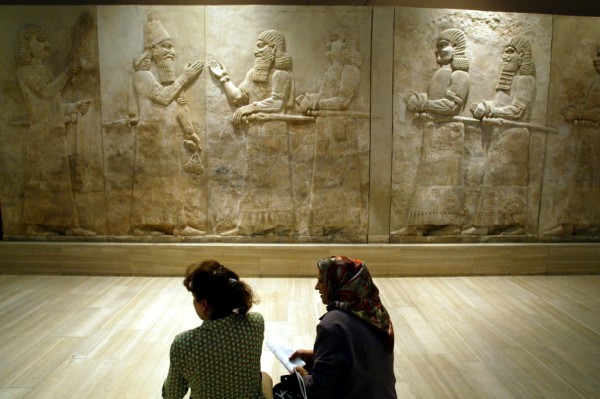Islamic State Militants Bulldoze Nimurd, An Ancient Iraqi City
| Arlene Lim | | Mar 06, 2015 08:17 AM EST |
(Photo : Reuters) Two Iraqi women talk in front of Assyrian mural sculptures July 3, 2003 as the Baghdad museum briefly re-opens to display ancient Nimrud treasures.
Islamic State militants have bulldozed and destroyed the ancient Assyrian City of Nimrud in Northern Iraq, a report by the Iraqi government and a local tribal member said.
A tribesman narrated that the Islamic State militants came to the Nimrud archeological city and stole valuable pieces. Then, they proceeded to level the site to the ground.
Like Us on Facebook
He added that the statues, walls and a castle have been completely destroyed.
Nimrud is located south of Mosul in Northern Iraq.
It was an ancient city in the Assyrian kingdom, which had flourished between 900 B.C. and 612 B.C. Its museum contains around 173 pieces of antiquity.
Iraq's Ministry of Tourism said the Islamic militants destroyed the antiquities to show their defiance to the world.
The ministry also stated that the IS assaulted the ancient city, appropriating the archeological attractions dating back to 13 centuries BC.
Authorities have not completely assessed the extent of the damage.
"Our ministry condemns these criminal acts. Letting these lost gangs go without punishment will encourage them to destroy humanity's civilization, especially the Mesopotamian civilization, and ultimately inflicting irreversible, priceless damage and loss," tourism officials said.
The Antiquities Ministry's director general of Iraqi museums, Qais Hussain Rashid, said that before the destruction, the place was being prepared for a reopening.
According to the World Monument Fund's website, Nimrud and the adjacent Nineveh are the sites where two Assyrian kings, Sennacherib and Ashurnasirpal II, had recorded on their palace walls their successful military adventures.
Encyclopedia Britanica's website, meanwhile, says, the buildings at Nimrud contain thousands of carved ivories, mostly made in the 8th and 9th centuries B.C.
It states that Nimrud currently has "one of the richest collections of ivory in the world".
TagsNimrud, Iraq, Islamic militants
©2015 Chinatopix All rights reserved. Do not reproduce without permission
EDITOR'S PICKS
-

Did the Trump administration just announce plans for a trade war with ‘hostile’ China and Russia?
-

US Senate passes Taiwan travel bill slammed by China
-

As Yan Sihong’s family grieves, here are other Chinese students who went missing abroad. Some have never been found
-

Beijing blasts Western critics who ‘smear China’ with the term sharp power
-

China Envoy Seeks to Defuse Tensions With U.S. as a Trade War Brews
-

Singapore's Deputy PM Provides Bitcoin Vote of Confidence Amid China's Blanket Bans
-

China warns investors over risks in overseas virtual currency trading
-

Chinese government most trustworthy: survey
-

Kashima Antlers On Course For Back-To-Back Titles
MOST POPULAR
LATEST NEWS
Zhou Yongkang: China's Former Security Chief Sentenced to Life in Prison

China's former Chief of the Ministry of Public Security, Zhou Yongkang, has been given a life sentence after he was found guilty of abusing his office, bribery and deliberately ... Full Article
TRENDING STORY

China Pork Prices Expected to Stabilize As The Supplies Recover

Elephone P9000 Smartphone is now on Sale on Amazon India

There's a Big Chance Cliffhangers Won't Still Be Resolved When Grey's Anatomy Season 13 Returns

Supreme Court Ruled on Samsung vs Apple Dispute for Patent Infringement

Microsoft Surface Pro 5 Rumors and Release Date: What is the Latest?













